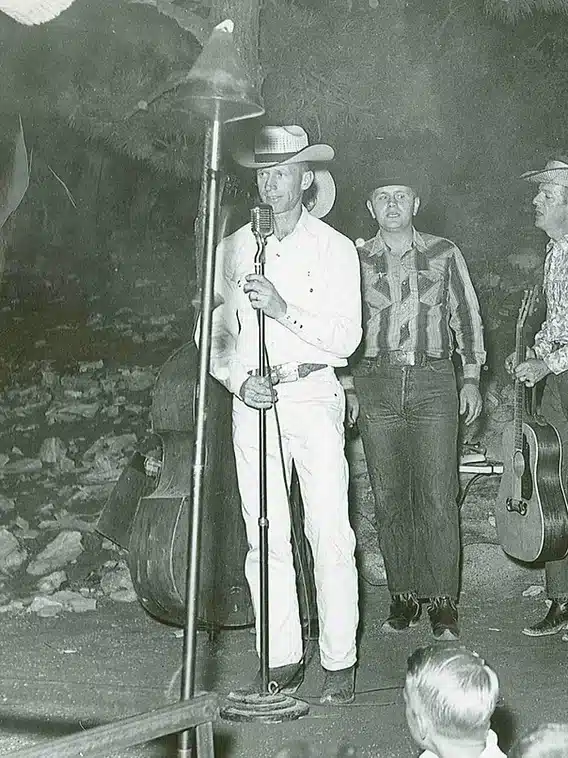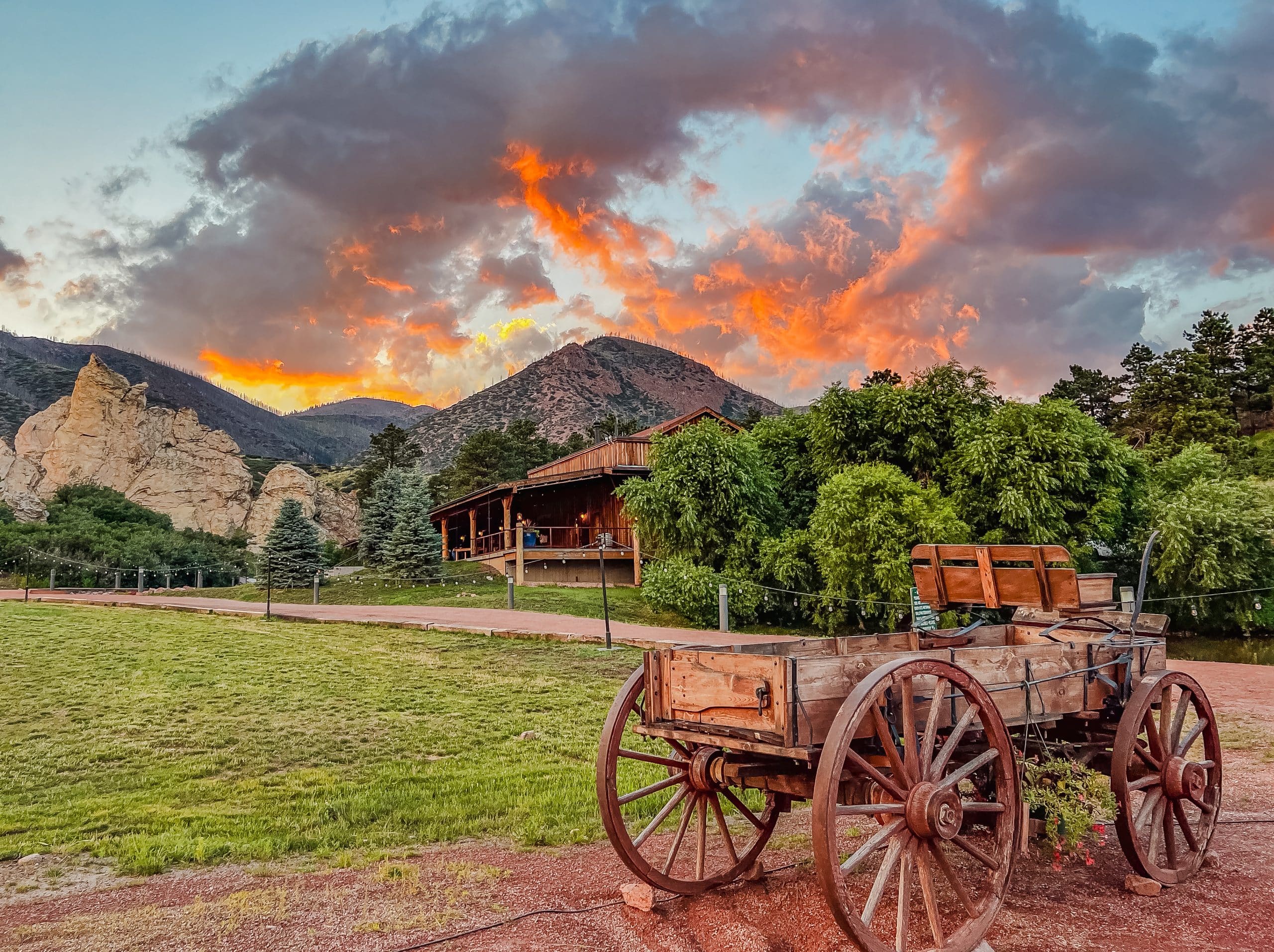
About the Flying W Ranch in Colorado Springs
A Piece of Living History, Steeped in Family Tradition
One of the last remaining original ranches in the state of Colorado, the Douglas Homestead became the historic Flying W Ranch in Colorado Springs, CO. The Flying W Ranch has been owned and worked by the same family since 1947. Hard work, integrity, and perseverance have been the deep-rooted values of the family for four generations. The Ranch is credited with introducing the quarter horse to the state of Colorado, raising champion Herford bulls, and rebounding from a devastating fire. The natural beauty of the Ranch is unmatched in the state of Colorado.
It Started with a Potluck
At age fifty-five, Don Wilson packed up his family and his three Kansas ranches and, in 1947, moved to the 1867 Colorado State Senator Robert Douglas homestead. The thousands of bucolic acres surrounding the homestead were nestled in the foothills of Pikes Peak, on the northwest side of Colorado Springs. The land was originally owned by William Palmer, the founder of Colorado Springs, and is adjacent to Palmer’s Glen Erie home. Don’s daughter and son-in-law, Russ and Marian Wolfe, moved to Colorado to help in the ranching operations. Black Angus cows were bred with Hereford bulls. The resulting Black Baldy calves were sold in the Fall. In addition, champion Quarter horses were raised and sold. Don and his older brother Harry were responsible for introducing the athletic Quarter horse to the states of Kansas and Colorado (the Quarter horses were purchased from the King Ranch in Texas). While wrangling with cows and horses, Russ and Marian continued to set their hearts on building the Chuckwagon Suppers and Original Western Stage Show business model.
During the summer, people would come out from town to ride horses over the extensive ranch lands with Russ Wolfe ramrodding the outings. Some evenings, the group would be small enough for Marian to invite the riders to share in a “potluck.” Russ and Marian decided to make the affair a regular event—a scenic horseback ride followed by a home-cooked meal under the stars around an open campfire. In 1953, with 11 paying guests at $3.00 each, the Chuckwagon dream was born.

Twenty Horses, Four Hundred People
On the second night, Russ and Marian served 7 people. Russ would bring water to the ranch in a 1937 Dodge pickup truck. There was one picnic table under a lean-to in the event of rain. All the food preparation was done in Russ and Marian’s modest home, and the pots were washed at the hydrant in their backyard.
During the first summer, Russ and Marian fed 1,650 people. They were open two nights a week. By the end of 1963, they were open seven nights a week serving over 125,000 people annually. Russ tells the story that, “In time, there were still twenty horses but four hundred people for dinner. Then there were twenty horses and eight hundred people for dinner, and then twenty horses and one thousand people. We finally just got rid of the horses.”
Life on the Ranch wasn’t easy in the early days, Russ and Marian had their share of raccoons and skunks in the kitchen, and rattlesnakes on the trails. There were run-away buses, keys locked in cars, bears in trash cans, cows in teepees, torrential rains, and washed out roads.

Visitors and local residents started coming out early to attend Russ and Marian’s Flying W Chuckwagon Suppers and Original Western Stage Show. Over time, Russ and Marian built a Western Village to further bring the Old West to life. The Flying W’s first building was the Trading Post. The logs used to build the Trading Post were recycled from the flag poles used at the National Girl Scout Jamboree that was held in Colorado Springs, on the Ranch, that same year. Russ obtained his Class A Contractors license so he could continue to build the Western Village. He gathered old siding, windows, show cases and a host of items from various places. He knew, in time, they would become part of a building that would tell a story of the Old West in design and style.
Building a Living Legacy – The Flying W Ranch in Colorado Springs
Over time, brick by brick, Russ and Marian built the unique and diverse Western Village. Eventually, 29 structures, including the Church, Jail, School House, Taos Pueblo, Printing Press, Kiva, Library, Drug Store, Homestead, Ute Theater, Train Depot, and more, were built or transferred to the Red Rock enclave. Navajo rug weavers, rodeos, silversmiths, ranch animals, Dutch-oven biscuits, and other forms of Old West demonstrations made the venue peerless.

Troubadours of The West – The Flying W Wranglers
The main highlight of Russ and Marian’s achievements at the Ranch was the introduction of the Flying W Wranglers. Western music was included in their initial vision, following the ride through the Ranch and the Chuckwagon meal. From 1953 to 1957, the performers ranged from college students and folk singers to the Sons of the Pioneers.
In 1957, the Flying W Wranglers were officially unveiled. Through the years, over 60 individuals have been a part of the Flying W Wranglers, with several of them performing for the Ranch for well over 30 years. The Flying W Wranglers are now the second- oldest Western performance band in the world. Their three-part-harmonies of time-honored tunes of the open range, high-quality instrumentation, and clean bunkhouse humor have delighted over seven million people from around the world.
In addition to performing at the Ranch, they performed in USO tours in Vietnam during the war; at the Grand Ole Opry in Nashville, Tennessee; in London, England; at the Kennedy Center in Washington, D.C., and at Carnegie Hall in New York City. The Flying W Wranglers have been featured in local and national television commercials, performed with several world-class symphonies, sung in major sporting events, and won a wide variety of musical awards. Given the deep legacy for the re-birth of the Ranch post-Waldo Canyon fire, over 300 musicians and entertainers were auditioned.
Great musicianship is a cornerstone of the entertainment at the Flying W Ranch in Colorado Springs. Join us for a Chuckwagon Supper and Original Western Stage Show, and see why the Flying W Ranch has become a fan-favorite staple of Colorado Springs history.